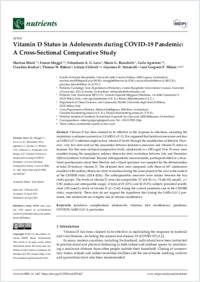Vitamin D status in adolescents during COVID-19 pandemic : a cross-sectional comparative study
- Meoli, Martina Faculty of Biomedical Sciences, Università della Svizzera italiana, Switzerland
- Muggli, Franco Faculty of Biomedical Sciences, Università della Svizzera italiana, Switzerland
- Lava, Sebastiano A. G. Pediatric Cardiology Unit, Department of Pediatrics, Centre Hospitalier Universitaire Vaudois, University of Lausanne, 1011 Lausanne, Switzerland
- Bianchetti, Mario G. Faculty of Biomedical Sciences, Università della Svizzera italiana, Switzerland
- Agostoni, Carlo Pediatric Unit, Fondazione IRCCS Ca’ Granda Ospedale Maggiore Policlinico, via della Commenda 9, 20122 Milan, Italy - Department of Clinical Sciences and Community Health, Università degli Studi di Milano, 20122 Milan, Italy
- Kocher, Claudine Swiss Department of Defence, Medical Intelligence, 3000 Bern, Switzerland
- Bührer, Thomas W. Swiss Department of Defence, Medical Intelligence, 3000 Bern, Switzerland
- Ciliberti, Letizia Pediatric Unit, Fondazione IRCCS Ca’ Granda Ospedale Maggiore Policlinico, via della Commenda 9, 20122 Milan, Italy - Department of Clinical Sciences and Community Health, Università degli Studi di Milano, 20122 Milan, Italy
- Simonetti, Giacomo D. Faculty of Biomedical Sciences, Università della Svizzera italiana, Switzerland - Pediatric Institute of Southern Switzerland, Ospedale San Giovanni, 6500 Bellinzona, Switzerland
- Milani, Gregorio P. Pediatric Unit, Fondazione IRCCS Ca’ Granda Ospedale Maggiore Policlinico, via della Commenda 9, 20122 Milan, Italy - Department of Clinical Sciences and Community Health, Università degli Studi di Milano, 20122 Milan, Italy - Pediatric Institute of Southern Switzerland, Ospedale San Giovanni, 6500 Bellinzona, Switzerland
-
2021
Published in:
- Nutrients. - MDPI. - 2021, vol. 13, no. 5, p. 7
Lockdown
Complications
Adolescents
Vitamins
Diet
Insufficiency
Pandemic
COVID19
SARS-CoV-2
Prevention
English
Vitamin D has been claimed to be effective in the response to infections, including the respiratory syndrome coronavirus 2 (SARS-CoV-2). It is supposed that lockdown measures and fear of SARS-CoV-2 infection might reduce vitamin D levels through the modification of lifestyle. However, very few data exist on the association between lockdown measures and vitamin D status in humans. For this cross-sectional comparative study, adolescents (n = 298) aged 18 to 19 years were enrolled during the compulsory military fitness-for-duty evaluation between July and December 2020 in Southern Switzerland. Beyond anthropometric measurements, participants filled in a structured questionnaire about their lifestyle and a blood specimen was sampled for the determination of total 25-hydroxy-vitamin D. The obtained data were compared with those of 437 adolescents enrolled at the military fitness-for-duty evaluation during the same period of the year in the context of the CENERI study (2014–2016). The anthropometric measures were similar between the two study groups. The levels of vitamin D were also comparable (77 (64–91) vs. 74 (60–92) nmol/L, p = 0.50; median and interquartile range). A total of 38 (13%) and 43 (9.8%) subjects presented insufficient (<50 nmol/L) levels of vitamin D (p = 0.42) during the current pandemic and in the CENERI study, respectively. These data do not support the hypothesis that during the SARS-CoV-2 pandemic, late adolescents are at higher risk of vitamin insufficiency.
- Language
-
- English
- Classification
- Medicine
- License
- Open access status
- gold
- Identifiers
-
- RERO DOC 333672
- DOI 10.3390/nu13051467
- ARK ark:/12658/srd1319285
- Persistent URL
- https://n2t.net/ark:/12658/srd1319285
Statistics
Document views: 226
File downloads:
- Texte intégral: 253
